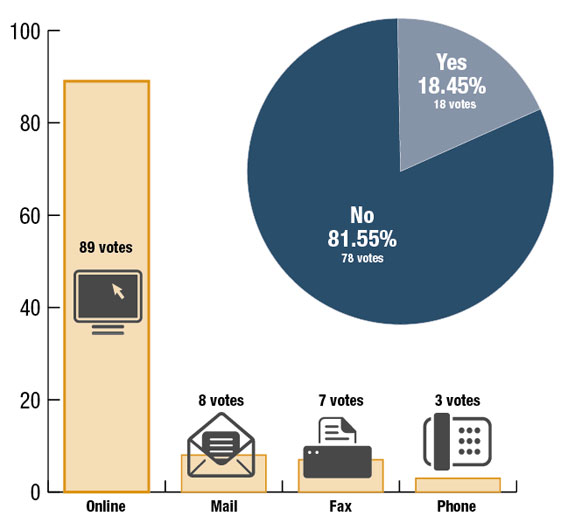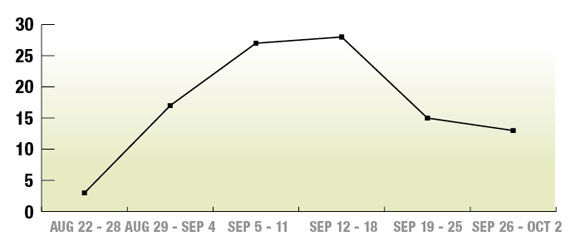The National Milk Producers Federation’s Board of Directors voted Sept. 21 in favor of a revised approach to reforming federal dairy policy, with the key change of allowing farmers an individual choice between receiving the financial protection of a government safety net or opting out of such protection. Scroll down or to jump below to see results and comments on this poll. And click here to read about the new poll question, "Do you support the Dairy Policy Act of 2011?" As originally proposed back in 2010, NMPF’s Foundation for the Future (FFTF) program contained a government-subsidized safety net, the Dairy Producer Margin Protection Program, to protect against periods of low milk prices, high feed costs or a combination of the two.
This program offered a basic level of subsidized insurance coverage, plus the option of supplemental fixed-cost coverage partially paid by farmers. The FFTF program also contained the Dairy Market Stabilization Program, which was a mandatory means to reduce market volatility by discouraging new milk production during periods of compressed margins.
Under the revised approach backed by NMPF, the Dairy Producer Margin Protection Program (DPMPP) would continue to be voluntary, but if a producer opts to participate in the DPMPP, his or her participation in the Dairy Market Stabilization Program (DMSP) would then be mandatory.
If a producer chooses not to participate in the insurance program, then participation in the DMSP would not be required. As with NMPF’s original reform package, the Milk Income Loss Contract program would be eliminated, as would the Dairy Product Price Support Program.
“Based on the feedback we received this summer from our cooperative membership, and during our grassroots tour, when 1,300 farmers came to 12 cities to talk with us about Foundation for the Future, we decided that a slightly different approach to reforming dairy policy was the best way to go,” said Randy Mooney, NMPF chairman, and a dairy farmer from Rogersville, Missouri.
“Clearly, a number of farmers are uncomfortable about having a mandatory government program to manage milk production. So we are endorsing a new approach which gives farmers a clear choice.
“This new approach of making the Market Stabilization program optional will appeal to those who philosophically do not want government telling them what to produce. At the same time, those who want the benefits of a government safety net must accept some government-led market stabilization as the price of that protection.”
Other changes include:
• Increasing the basic plan’s coverage to 80 percent of a producer’s production history on margins between $0.00 and $ 4.00 per hundredweight. In the legislative draft of FFTF released earlier this summer, the basic coverage was limited to 75 percent of a farm’s production history.
• Giving farmers the option of acquiring coverage for their production growth under the supplemental plan. Under such an option, the production history would be revised annually as the producer’s production grows. The percentage of the producer’s production history to be covered, and the premium rate per hundredweight, would remain fixed over the life of the Farm Bill.
• Accepting an administrative fee to be charged to all producers signing up for margin protection coverage under the DPMPP, with modest fees on a sliding scale. This will help keep the cost of the program to a minimum.
• Eliminating the distribution of 50 percent of producer-generated funds to the U.S. Treasury under the DMSP, ensuring that all of the monies generated by producer withholdings would be available to purchase dairy products for donation to non-commercial food assistance programs as originally proposed.
Lastly, the revised FFTF package endorsed by NMPF alters how reforms to the Federal Milk Marketing Order system would be pursued. Under NMPF’s original approach, the legislation would have specifically prescribed how competitive prices and a streamlining of the classified pricing system were to be implemented by the USDA, without a hearing process.
The new version directs the USDA to eliminate the cumbersome end-product price formulas and make allowances for Class III, and use a competitive pay price instead to determine the Class III price.
It also specifies that after USDA makes its decision, a majority vote by producers will put the changes into effect. If the changes are not approved, the current Federal Order provisions remain in place.
“The underlying objectives we have been pursuing for the past two years – offering a better dairy program featuring protection, stability and growth – remain intact in what our board has endorsed,” according to NMPF President and CEO Jerry Kozak.
“But by making some adjustments, we strongly believe that many of the concerns raised in the past year to our first approach now have been addressed and eliminated.”
Kozak said that the proposal allowed the dairy industry and Congress “to kick the tires and really scrutinize the best way to reform dairy policy. We’ve listened, we’ve analyzed and considered options, and now we’re endorsing a course correction that will still take us to the same place, only with greater unanimity and support from dairy farmers, and hopefully from others across the industry and on Capitol Hill.”
Dairy Security Act of 2011
The bipartisan “Dairy Security Act of 2011” was formally introduced Sept. 23 by the House Agriculture Committee’s Ranking Member Collin Peterson (D-Minnesota), along with senior House Republican Mike Simpson (R-Idaho).
The bill is modeled on the dairy reforms developed and promoted by NMPF, and would revamp and improve the farm-level safety net for dairy producers.
The bill is somewhat different from the legislative discussion draft introduced by Peterson this summer. It reflects the new changes outlined above.
The Congressional Budget Office has evaluated, or scored, the legislative draft to assess its budget impact and finds that the DSA will reduce federal spending by $167 million during the next five years, and $131 million during the next 10.
That level of savings “represents one of the major benefits of this approach, since it will not only provide farmers better security, but also save the government money when the main topic of conversation in Washington is on reducing the deficit,” Kozak said. P D
—Compiled from NMPF news releases
RESULTS AND COMMENTS

No: Not as presented – it needs to be modified to make it a dairyman’s bill and not a processor bill. We need earlier notice on cutbacks in production and need to have at least a $2.00 to $2.50 milk-feed ratio.
Mary Parente
Ontario, California
No: We already have too much government regulation from the EPA and others.
Donald Stephens
Mammoth Springs, Arkansas
No: No rational-thinking person could think this is a good idea. Unless you are connected with the large co-ops, this will make us serfs to the lords of milk processors. The more you read about it, the more frightening it becomes.
Dan Vaughan
White Hall, Maryland

No: Absolutely no. Don’t think all details are known. Let the market that we have now work. Being drawn up by a Democrat. We don’t trust it. Too open-ended. Not enough detail. We would rather stay with the set-up we now have where there is incentive to produce and produce high-quality products.
Thurlow Y Cowles
Marietta, New York
No: We don’t need more insurance. Jerry Kozak and Colin Peterson are not dairymen-friendly. We don’t need to be giving money to the government. We need the Federal Milk Marketing Improvement Act of 2011.
Thomas Johnson
Airville, Pennsylvania
No: I believe New Zealand had the government step back from being involved in price protection. Maybe we should check with them and see how they like it. Less control may be better.
Darrell Richard
Goshen, Indiana
GRAPHS
Top right: Pie chart shows "Yes" and "No" votes by total and percentage. Graph shows votes received by online, mail, fax and phone.
Bottom right: Line graph shows votes received per week.



